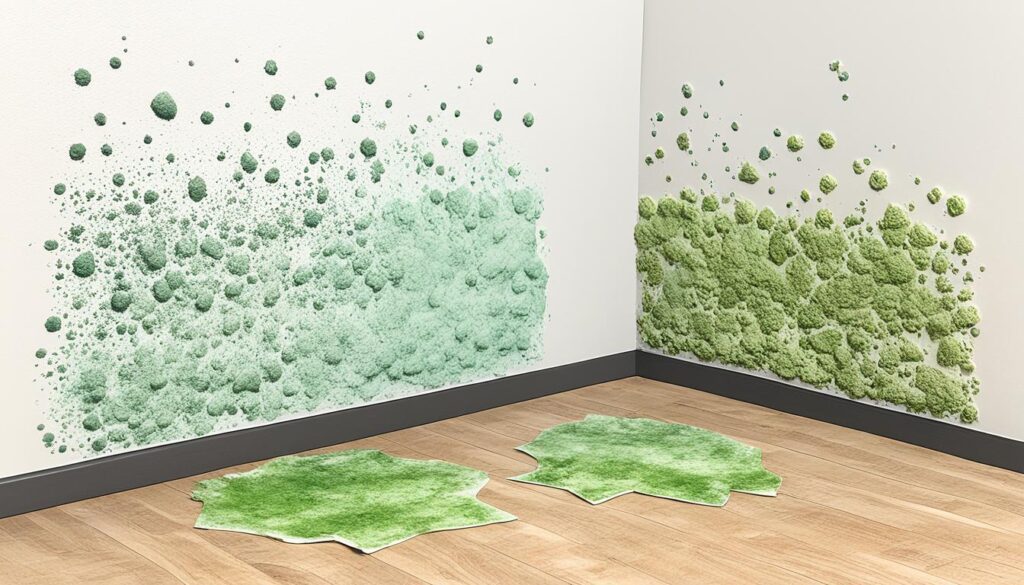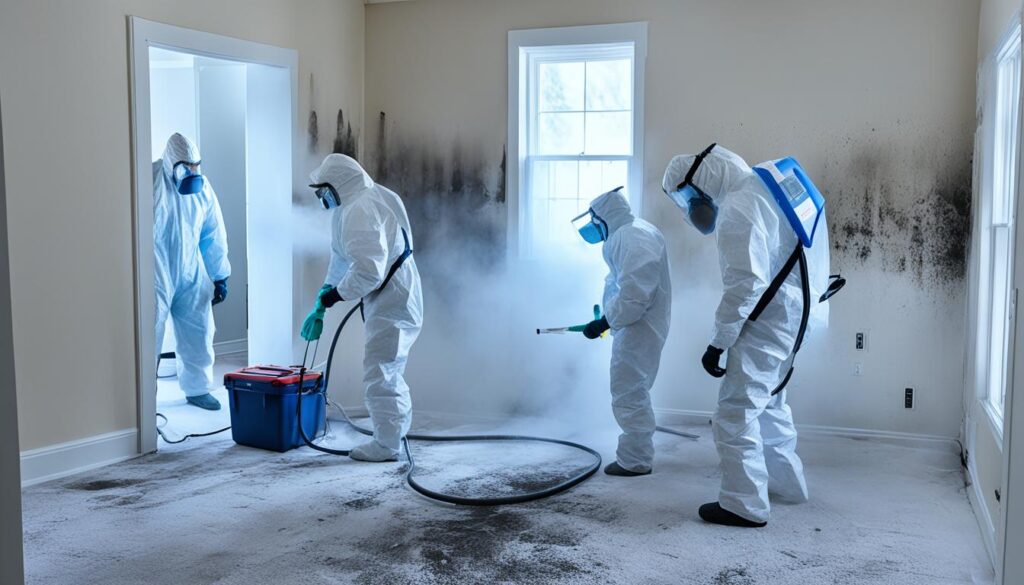
Mold Remediation Process in Residential Areas
Welcome to our comprehensive guide on the mold remediation process in residential areas. If you’re dealing with mold issues in your home, it’s crucial to understand the steps involved in safely and effectively removing mold. By following the right procedures, you can ensure a healthier living environment for you and your family.
Mold infestations in residential properties can occur due to various factors such as water leaks, humidity, or inadequate ventilation. When left untreated, mold can not only cause structural damage but also pose potential health risks to occupants.
To address mold problems, it is important to follow a well-defined remediation process. This involves a series of steps aimed at identifying, containing, removing, and preventing the spread of mold. Whether you decide to tackle the issue yourself or hire a professional mold remediation company, understanding the process is essential.
Throughout this guide, we will highlight the key steps involved in residential mold remediation, providing you with valuable insights and tips to ensure effective mold removal. From initial assessment to the final prevention measures, we will cover each stage of the process in detail.
Key Takeaways:
- The mold remediation process in residential areas involves a series of steps to safely and effectively remove mold.
- Mold infestations can occur due to various factors, including water leaks, humidity, and inadequate ventilation.
- Proper mold remediation helps address structural damage and potential health risks to occupants.
- Whether you choose to handle mold removal yourself or hire a professional mold remediation company, understanding the process is crucial.
- This guide will provide valuable insights and tips on each stage of the mold remediation process in residential areas.
Understanding Mold and Its Risks
Mold is a type of fungus that thrives in damp and humid environments. It can grow on various surfaces, such as walls, ceilings, carpets, and furniture. While some forms of mold are harmless, others can pose significant health risks to individuals exposed to them. Understanding these risks and taking appropriate action is crucial for maintaining a safe and healthy living environment.
Mold spores are tiny particles that are released into the air by mold colonies. When inhaled or come into contact with the skin, these spores can cause a range of health problems, especially for individuals with allergies, asthma, or weak immune systems. Common symptoms include nasal congestion, coughing, wheezing, eye irritation, and skin rashes. Prolonged exposure to mold can even lead to more severe respiratory issues and infections.
When faced with a mold problem in your home, it’s essential to consider the best course of action. While some minor mold issues can be addressed through DIY methods, it’s important to recognize that professional mold remediation services offer distinct advantages. Hiring experts in mold inspection and remediation ensures a thorough assessment of the extent of the mold problem and the implementation of effective remediation strategies.
“Professional mold remediation services provide the expertise, tools, and equipment necessary to handle mold issues safely and effectively, minimizing the risk of further contamination and ensuring a thorough cleanup.”
Professional mold remediation services have the experience and knowledge to identify the root cause of mold growth and address it appropriately. They also have access to specialized equipment and techniques to contain the mold, safely remove affected materials, and restore the affected areas. By entrusting the job to professionals, you can have peace of mind knowing that the mold problem is treated comprehensively and with minimal disruption to your daily life.
DIY Mold Remediation: Know the Limitations
While some small-scale mold problems can be handled with DIY methods, it’s important to recognize the limitations. DIY mold remediation may be suitable for minor surface-level mold growth on non-porous materials. However, when dealing with extensive mold infestations or mold growth on porous materials like drywall or carpet, professional intervention is strongly recommended.
The main challenge with DIY mold remediation is ensuring thorough and proper removal of the mold. Inadequate cleaning can result in incomplete removal, leading to recurring growth and potential health risks. Additionally, improper handling of mold-contaminated materials can cause the spread of mold spores to unaffected areas of the home.
Ultimately, the decision between DIY mold remediation and professional services depends on the severity of the mold problem, the affected areas, and your expertise in handling mold safely and effectively. It’s crucial to prioritize the health and well-being of yourself and your family when deciding which approach to take.

| Factors | Professional Mold Remediation Services | DIY Mold Remediation |
|---|---|---|
| Expertise | Highly trained professionals knowledgeable in mold remediation techniques. | Reliance on personal knowledge and online resources. |
| Equipment and Tools | Specialized equipment and tools for containment, removal, and cleanup. | Rely on standard household tools. |
| Assessment and Identification | Thorough assessment of mold growth, identifying the source and extent of contamination. | Reliance on visual inspection, may miss hidden mold or underlying issues. |
| Remediation Strategy | Tailored approach based on the specific mold problem and affected areas. | Generic strategies with limited effectiveness for larger or complex mold infestations. |
| Health and Safety | Adheres to industry guidelines for personal protective equipment (PPE) and containment procedures to minimize exposure to mold and prevent cross-contamination. | Relies on personal protection and may overlook proper containment procedures. |
| Efficiency | Efficient and timely completion of mold remediation, minimizing disruption to daily life. | May take longer to complete the process, leading to prolonged exposure to mold. |
Steps of the Mold Remediation Process
When dealing with mold in a residential setting, it is crucial to follow a systematic process to ensure its effective removal and prevent future growth. The mold remediation process involves several key steps that must be executed properly to achieve thorough results. Let’s explore each step in detail:
- Initial Assessment: The first step in mold remediation is to conduct a thorough assessment of the affected areas. This involves identifying the extent of the mold growth, determining the type of mold present, and assessing any potential risks to the residents’ health.
- Containment: To prevent the spread of mold spores to unaffected areas, containment measures must be put in place. This may include sealing off the contaminated area, using barriers or negative air pressure machines, and ensuring proper ventilation to minimize cross-contamination.
- Removal of Contaminated Materials: All mold-infested materials, such as drywall, carpeting, or furniture, must be carefully removed and disposed of according to local regulations. This step ensures the elimination of the source of mold growth and reduces the likelihood of recontamination.
- Cleaning and Disinfection: Once the contaminated materials are removed, the affected surfaces must be thoroughly cleaned and disinfected. This helps to eliminate any remaining mold spores and prevent their regrowth.
- Drying and Dehumidification: Mold thrives in damp and humid conditions, so it is crucial to dry the affected area thoroughly. This may involve using specialized drying equipment and dehumidifiers to remove excess moisture and create an environment unsuitable for mold growth.
- Final Inspection: After completing the remediation process, a final inspection is necessary to ensure that all mold has been successfully removed. This involves assessing the air quality, conducting surface tests, and verifying that the indoor environment is safe for occupancy.
- Preventive Measures: To minimize the chances of future mold growth, preventive measures should be implemented. This includes addressing any moisture issues, improving ventilation, and maintaining proper humidity levels in the home.
It is important to note that the mold remediation process for residential areas should be carried out by experienced mold remediation experts. Their knowledge and expertise ensure that the process is executed effectively, addressing all potential risks and providing a safe, mold-free environment for residents.

By following these steps and relying on the expertise of mold remediation professionals, you can effectively address mold issues in your residential property, ensuring the health and well-being of you and your family.
Conclusion
In conclusion, mold remediation is an essential process for maintaining a healthy residential environment. Mold growth can pose serious risks to both the structural integrity of your home and the health of its occupants. Therefore, hiring a professional mold remediation company is crucial to ensure a thorough and effective removal process.
While the cost of mold remediation may vary depending on the extent of the infestation and the size of the property, it is a worthwhile investment in the long run. Ignoring mold issues or attempting to remove it yourself can often lead to incomplete removal and recurring mold problems.
By taking prompt action and engaging the services of experienced mold remediation professionals, you can address mold issues effectively, preventing further damage and protecting the well-being of your family. Remember, the sooner you address mold growth, the easier and less costly the remediation process will be.




